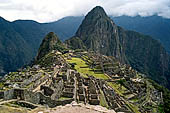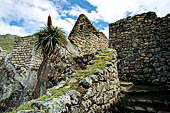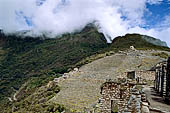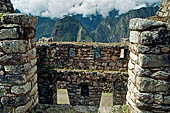| enter keyword to search: |
|
Images db
|
|
|
Articles db
|
|
|
|
|
|
|
| Machu Picchu: The citadel |
|
The real attractiveness of Machu Picchu, a UNESCO World Cultural Heritage Site, lies in its squares, aqueducts and watchtowers, its observatories and in its sun clock, evidence of the wisdom and skill of the city's Andean builders. The surprising perfection and beauty of Machu Picchu walls, built by joining stone to stone without using any cement or adhesive whatsoever, has led to legends on how the city was constructed. It is said that a bird by the name of Kak'aqllu knew the formula for softening rock but by command, perhaps, of the ancient Inca gods, had its tongue torn out. It is also said that there was a magic plant that could dissolve and compress stone.
Machu Picchu |

|
Home to over 500 people the complex consists of several structures, tombs and a large area that was used for dwellings. It contains many buildings in the finest interlocking Inca masonry. Here, standing intact to the roofline, there are houses, temples and buildings of a complete Inca city with remarkable unity and state of preservation. The house groups are set amid banks of tidy agricultural terraces bound together by hundreds of stone stairways and canals.
The citadel is split into two major areas: the agricultural zone, made up of terraces and food storehouses; and the urban zone, featuring the sacred sector, with temples and various buildings.

|
Machu Picchu
|
The agricultural sector consists of stepped terraces, also known as 'andenes', built on the slopes of surrounding mountains. The terraces of different types and sizes had both the agricultural function and halt the erosion caused by the rains. They begin at the cluster of rooms located at the entrance and climb up to the top of the mountain. It is clear that the upper terraces at the entrance were meant for agricultural purposes as they have raised steps and are much wider. The lower terraces, meanwhile, were built as foundations. There are no canals as they were not necessary, as the constant rains and ever-present humidity allowed the plants to grow without irrigation. The only water channel that flows through the urban sector crosses through the central terrace.
Machu Picchu |

|
Access to the Urban sector, which is clearly differentiated from the agricultural sector by a large perimeter wall, is via a beautiful lithic porch with double jambs. The urban sector has two large groups of buildings around a grassy plaza with streets and stairs as well as a network of water canals, interspersed with small squares and courtyards. At Machu Picchu and other Inca sites, buildings opened on one side, known as 'masmas', are common. Most Inca buildings were rectangular, featuring steeply sloping gable walls at the narrow ends. Roofs were thatched. A number of buildings have been "restored", with roofs constructed in much the same manner as sketched by Hiram Bingham, the discoverer of Machu Picchu, in his hypothetical reconstructions of Inca roofing.
Doors and windows are encased in trapezoidal shapes, as are the niches in the walls where idols and other objects were placed, a typical feature of Inca architecture. Each wall in Machu Picchu is different; even those that share the same enclosure have different styles. Doors are a common sight in this sector. They vary in size and architectural style although all have the same trapezoidal shape. They have doorjamb, stone rings for beams. The area houses also a series of 17 springs, real masterpieces, beautifully built on the rock; fed by underground springs, the water is distributed with a system of canals that permits an harmonious flow to the lower section.

|
Machu Picchu
|
The Temple of three windows (Templo de las Tres Ventanas) is located West of the main square, its main face has three windows and two blind bays. The enormous granite blocks have been carved and perfectly fit together. It was suspected to be the never found legendary temple with the three windows: the symbol of the caves where the divine Father of the first Inca Manco Capac lives.
From the Sacred Plaza a stairway leads up to a beautiful pyramid made up of several terraces that overlooks the whole city. The top of the hill is flattened to enable the construction of an enclosure.
There, in the centre, the Inti-huatana, (the Hitching Post of the Sun) the monolith stone with astronomical-calendar purposes used for determining the solstices, to make sure that the Sun be bound and not keep moving away without being pulled back to return. This fascinating rock is one of the few that were not destroyed by the conquistadores.
Machu Picchu |

|
Among the most outstanding structures of the urban section is the Torreón, a semi-circular building raised on a great rock outcrop. Also known as the Temple of the Sun in the temple built with perfectly fit stones, there is a little Intihuatana serving as a solar observation place. There are also some trapezoidal windows pointing to the solstices.

|
Machu Picchu
|
Underneath the circular Temple of the Sun, you'll find the Temple of the Condor is ingeniously created from a natural rock formation resembling the outspread wings of a condor in flight. On the floor of the temple is a rock carved in the shape of the condor's head and neck feathers, completing the figure of a three-dimensional bird.
Under the Condor temple is the Royal Tomb. This cave-like area contains ceremonial human-sized niches and an underground maze of caves. Carved from one wall a series of steps represents the three levels of existence in the world of the Inca. The first step, symbolized by the snake, represents the underworld or death. The second step represents the present, human life, and is symbolized by the jaguar. The highest step represents the celestial/spiritual plane of the gods, and is symbolized by the condor. The Royal Tomb has been the site of numerous mummy excavations.
At the far end of Machu Picchu is the Sacred Rock, an object common to most every Inca village. Before a village could be erected, a sacred stone must be dedicated to the site. This rock, flanked by two three-sided rooms, is a monolithic upright slab put on a pedestal and cut to resemble the shape of the nearby Pumasillo. It is possible that this cluster of constructions, together with two "Wayranas", or three-sided rooms, were used for rituals.
The Sacred Rock sits at the base of Huayna Picchu (the young mountain), the famous background of the citadel. Here an Inca’s road leds you to the Huayna Picchu top and, with a beautiful path that crosses the cloud forest, to the temple of the Moon.
Machu Picchu |

|
Temple of the moon
Partway down the northern side of Wayna Picchu Mountain inside a cavern there is the so-called Temple of the Moon. The temple is well down the mountain just above the Urubamba River, to approach the site an Inca route branches off from the trail up Huayna Picchu to descend downward. The site is a large shelter cave with masonry structures with associated small terraces and several small groups of buildings. Finely worked granite walls with niches and recesses inside the cave that faces outward the San Miguel ridge. A large shaped stone inside appears to replicate the profile of San Miguel ridge. Caves were important to the Inca, representing sacred places embodied with spiritual powers. Although there is no archaeological or iconographical evidence to substantiate the assumption that this cave was a sacred site, immersed in a beautiful forest on the shear side of the mountain with finely carved structures on large boulders, the place is really fascinating.

|
Machu Picchu
|
The Inca Drawbridge
A narrow and airy path starts from the higher quarter of the citadel and leads to the Inca bridge, the path rounds the steep side of the mountain above dizzy heights, you can walk for about 2 km before a land slip stops you, from here it is possible to spot a small bridge made of tree trunks bridging a gap of the path. The legend says that was the way the inhabitants of Machu Picchu could safely retreat in case of attack removing the trunks behind them.
|
Related Pages
-
-
-
-
-
-
-
-
|
|
|
 |
|
|



